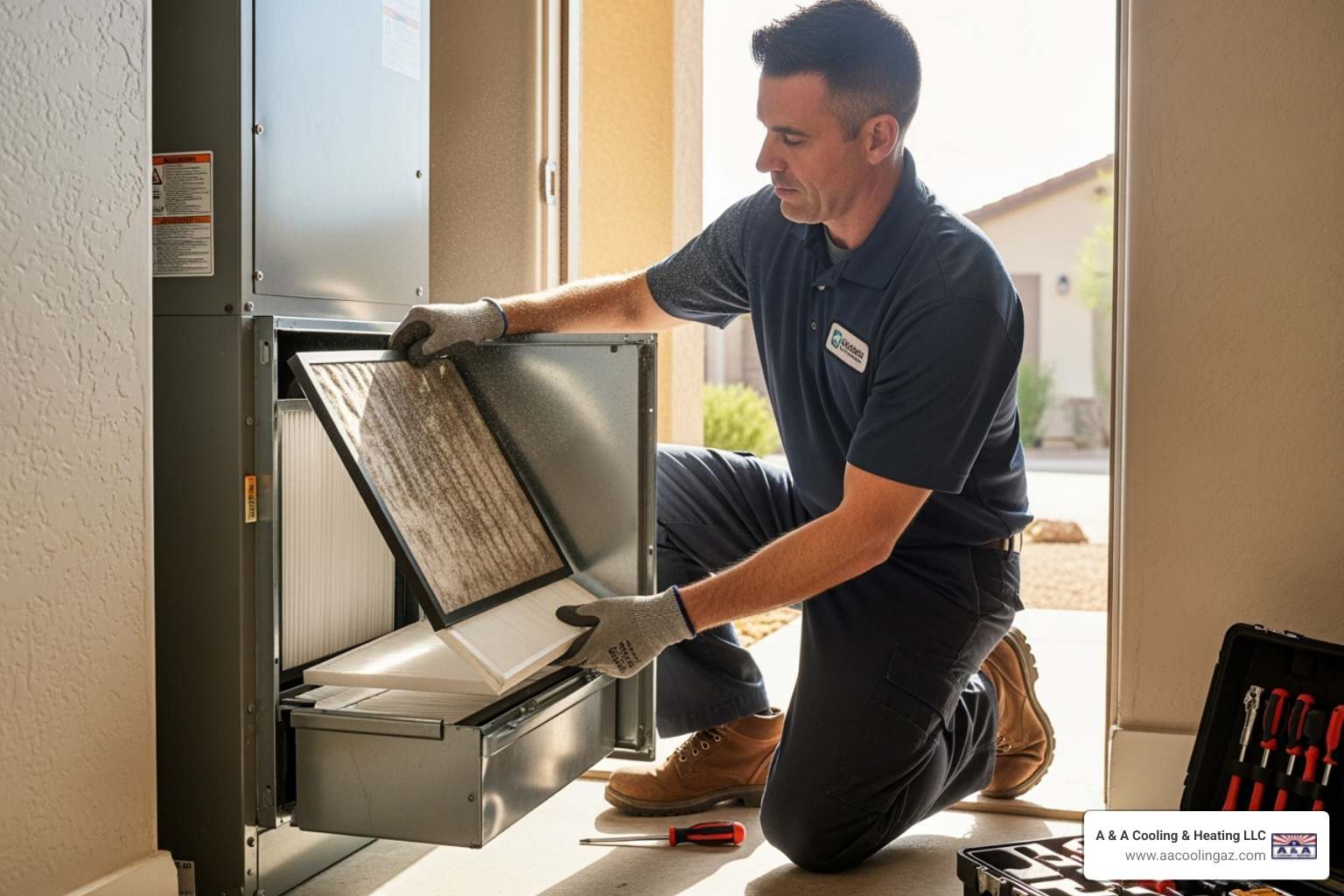Heat Pump Emergency Heat Running Constantly in Tempe

If your heat pump’s emergency heat setting won’t turn off, it’s not something you can ignore. Homeowners in Tempe rely on their systems to handle the late summer heat and the steady transitions between seasons. When that backup heat runs nonstop, it typically means the system’s efficiency is compromised, and your energy bills could rise. Even more importantly, the problem may be signaling that something critical is wrong with the main components of the heat pump.
Emergency heat is meant to be a safety net. It kicks in when the main heat pump can’t keep up or fails due to an issue. But if it stays on longer than it should, that’s no longer a backup — it’s a red flag. Whether it’s due to faulty electronics, a refrigerant problem, or thermostat troubles, a constantly running backup heat mode is a warning sign Tempe homeowners shouldn't overlook. Getting to the root of it quickly helps avoid system damage and may save on a more expensive heat pump replacement later.
Common Causes for Constantly Running Emergency Heat
If the emergency heat is stuck on, chances are something else isn’t working correctly. A few common culprits cause this issue, and most of them point to problems that need attention from trained professionals.
Here are the top reasons why the emergency heat might be running constantly:
1. Thermostat malfunctions
Incorrect or faulty thermostat settings can trigger the emergency heat to turn on and stay on. If the thermostat fails to read the temperature accurately or doesn’t switch signal modes properly, it may keep the system in emergency mode for too long.
2. Defrost cycle problems
When the outdoor unit starts freezing or doesn’t switch between heating and defrost cycles correctly, it can cause the system to rely on emergency heat more often. In some cases, a failed sensor prevents the heat pump from cycling properly, leaving it stuck in backup mode.
3. Low refrigerant levels
If the refrigerant is low, the system can't transfer heat effectively. As a result, the main pump can’t warm your home as needed, and the system falls back on emergency heat. This often suggests a leak and requires professional repair before the issue worsens.
4. Electrical issues
Wiring or control board failures can direct the system into its backup mode. A blown fuse or failing relay can also break vital communication between system components. This not only triggers emergency heat, but also risks system failure if ignored.
5. High demand due to temperature extremes
While rare for Tempe, when outdoor conditions become unusually demanding or the unit has aged, the heat pump might struggle to keep up. This stress on the system can cause it to rely more heavily on the emergency setting as a crutch.
One example that comes up often from local homeowners: an older heat pump system in Tempe that starts using emergency heat every evening even when temperatures are mild. On inspection, the problem usually comes down to an internal sensor failure or a refrigerant issue. These aren’t surface-level fixes — only experienced technicians can properly diagnose and resolve them.
Leaving a constantly running emergency heat issue unchecked can shorten the lifespan of the unit and increase costs in the long run. Instead, it’s best to treat it as a clear signal that your heat pump needs immediate inspection. Sometimes the solution is simple, but other times, it may be smarter to look at replacing the system altogether, especially if the backup modes are being used too frequently.
Signs That Your Heat Pump Needs Immediate Attention
You may not always catch a heater problem early on, especially in the middle of a busy week. But if your system keeps turning on emergency heat mode, it’s time to look for these warning signs:
- Climbing energy bills without an obvious increase in usage
- The house still feels cold or has uneven warmth, requiring constant thermostat changes
- Odd noises, like humming, buzzing, or clicking coming from the outdoor unit
- The system starts and stops more often than usual, pointing to cycling issues
- You see frost or ice buildup on the outdoor coil even in mild conditions
Any of these symptoms paired with always-on emergency heat is a signal that your heat pump isn’t operating as it should. If ignored for too long, minor repairs can become bigger problems. For example, frequent cycling mixed with poor warmth can be a sign that the compressor is straining or even failing, which could make a replacement more likely.
At this point, a professional will need to run diagnostic tests that check if the system components are still in good shape. Whether the drain line is clogged, refrigerant levels are off, or the motor is strained, catching the issue early can make a difference between a quick fix and full system replacement.
Importance of Professional Inspection and Maintenance
When your heat pump starts running emergency heat nonstop, it’s no time to guess what the problem might be. Diagnosing issues like low refrigerant, defrost system failure, or electrical faults isn’t something that can be accurately done without the proper tools. Our professionals have the right equipment and training to check your system’s internal components carefully. Skipping this step could mean patching surface issues while the root problem continues to wear your unit down.
Ongoing maintenance plays a big role in stopping these problems before they start. During a routine inspection, our technicians can clean built-up debris, replace worn components, and ensure the electrical systems are responding the way they should. These checkups help catch early signs before your heat pump gets locked into defaulting to emergency heat or worse, stops working altogether.
Trying to handle major heat pump concerns on your own comes with risk. Even something as simple as misreading a thermostat error can lead you to bypass the bigger issue. Some homeowners try to reset their systems repeatedly or change the temperature setting too aggressively, which may make the problem worse. A system running emergency heat day after day is under stress. When our technicians step in early, there’s still a chance to restore normal function without permanent damage.
When Replacement Becomes a Better Option
If your heat pump keeps depending on emergency heat despite repairs and inspections, it may be time to consider replacing it. Systems that are more than 10 to 15 years old are usually less efficient and more prone to recurring issues. If your unit is working harder and still struggling to keep your home warm, you may be spending more on energy than a new unit would cost in the long run.
Here are some signs replacement makes more sense:
- Frequent repairs or breakdowns even with regular maintenance
- Rising energy bills with no major changes indoors
- Inconsistent comfort from room to room
- Unusual sounds or smells that come back even after servicing
- The system turns on emergency heat more often than not
Upgrading to a newer heat pump brings clear benefits. Modern models are built to handle local temperature swing issues more effectively and come with improved energy efficiency ratings. That means you get stronger performance with less power use. These systems also include enhanced defrost cycles and updated thermostats that adjust faster and more accurately. Combined, those features reduce the chance of the unit switching prematurely into emergency heat mode.
Not only will a replacement optimize indoor comfort, but it can also reduce wear and tear on your HVAC system overall. Many new heat pumps offer better humidity control and quieter operation, which improves comfort without spikes in your energy bill. If your current system is nearing the end of its life and struggling regularly, planning ahead can prevent the hassle of a surprise failure in the middle of a temperature swing.
Ensuring Comfort in Your Tempe Home
Dealing with emergency heat running around the clock is more than an inconvenience. It’s often a red flag that your heat pump needs professional attention, whether it’s a sensor issue, refrigerant loss, or electrical failure. Letting the system run this way puts pressure on the equipment and makes it harder to keep your home comfortable without racking up inflated utility bills.
Regular inspections can prevent bigger issues from developing. Even better, if your system is reaching the end of its lifespan, upgrading your unit could be the smarter move. A replacement heat pump provides reliability, stronger performance, and less frequent reliance on emergency heat. Whether addressing repairs or planning for a new system, making the right move at the right time gives you dependable heating and better peace of mind.
When persistent emergency heat or constant cycling indicates that your system is struggling, scheduling a professional inspection is crucial to maintain a comfortable home in Tempe. If repairs and routine maintenance no longer seem to solve the problem, it might be time to consider a heat pump replacement in Tempe that offers improved efficiency and lasting reliability. A & A Cooling & Heating LLC is dedicated to ensuring your system’s longevity and performance; for a quick estimate or to book a service visit, please contact us today.



















